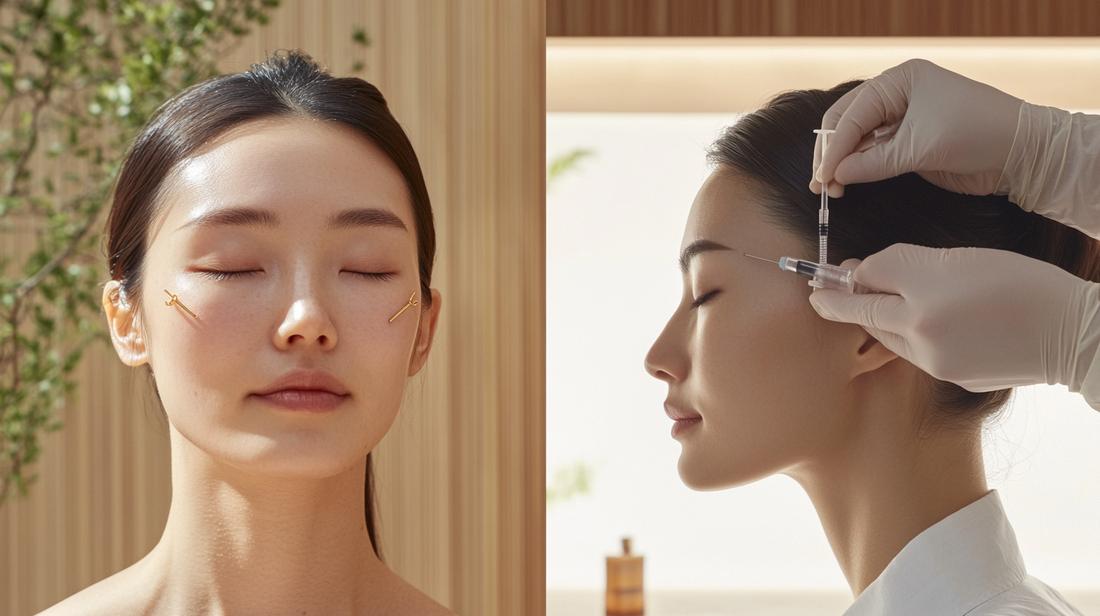
Cosmetic Facial Acupuncture vs. Botox: What to Know
Share
Introduction
When it comes to enhancing your appearance, two popular options are cosmetic facial acupuncture and Botox injections. Both aim to smooth wrinkles, lift features, and refresh your skin—but they work in entirely different ways. One taps into your body’s natural healing and energetic systems. The other temporarily paralyses facial muscles.
As more people seek natural, holistic alternatives to cosmetic procedures, facial acupuncture has grown in popularity for its ability to improve skin tone, reduce puffiness, and soften lines—without toxins or downtime.
In this blog, we’ll break down how facial acupuncture compares to Botox in terms of method, benefits, safety, cost, and long-term effects. We’ll also explain what research says and share client stories from Vital Duo.
What Is Cosmetic Facial Acupuncture?
Cosmetic facial acupuncture uses fine, sterile needles inserted into specific points on the face and body to:
- Stimulate local circulation
- Boost collagen and elastin production
- Relax overactive muscles and lift sagging tissue
- Support the body’s overall Qi and blood flow
It’s based on Traditional Chinese Medicine (TCM) principles, treating both the face and underlying internal imbalances.
Key Benefits:
- Natural anti-aging without chemicals
- Improved skin tone and texture
- Reduced puffiness and facial tension
- Better sleep and stress relief (whole-body effects)
“Facial acupuncture improves microcirculation and muscle tone while restoring energetic balance.” — Journal of Chinese Medicine, 2022
What Is Botox?
Botox is a brand name for botulinum toxin, a neurotoxic protein injected into muscles to temporarily block nerve signals. It works by paralysing or weakening facial muscles that cause wrinkles, especially:
- Forehead lines
- Crow’s feet
- Frown lines between the eyebrows
Key Benefits:
- Quick results (within 3–7 days)
- Lasts 3–6 months
- Widely used and medically regulated
"Botox is a fast-acting cosmetic injectable with proven wrinkle-reducing effects." — American Academy of Dermatology, 2021
How They Work: Mechanism of Action
| Feature | Facial Acupuncture | Botox |
|---|---|---|
| Stimulates collagen? | Yes, via natural healing | Indirect, minimal effect |
| Relaxes muscles? | Yes, balances tone | Yes, through paralysis |
| Treats puffiness? | Yes, improves lymph flow | No effect |
| Addresses underlying causes? | Yes, including digestion, hormones, stress | No |
| Whole-body benefits? | Yes | No |
Summary:
Facial acupuncture works with your body. Botox works against specific muscles.
Results: What You Can Expect
Facial Acupuncture
- Gradual, natural lift and tone
- Brighter complexion, fewer breakouts
- Softer lines over 5–10 sessions
- Side benefits like better sleep, less stress
Botox
- Smooth, wrinkle-free areas within 1 week
- “Frozen” look if overused
- No improvement in skin health or tone
Dermatologic Surgery (2020): Botox reduced wrinkle severity by 60–80% within 30 days but had no long-term skin quality benefits
Journal of Cosmetic Acupuncture (2021): Facial acupuncture improved elasticity, tone, and skin hydration by 25–35% over 6 weeks
Safety and Side Effects
Facial Acupuncture
- Minimal risks when performed by a qualified practitioner
- Possible mild bruising or redness
- No toxins, no downtime
Botox
-
FDA-approved but carries risks:
- Droopy eyelids
- Headaches
- Muscle weakness or asymmetry
- Contraindicated in pregnancy or neuromuscular conditions
Duration and Maintenance
| Factor | Facial Acupuncture | Botox |
| Results visible | After 3–5 sessions | Within 3–7 days |
| Maintenance | Monthly or seasonal | Every 3–6 months |
| Cumulative benefit? | Yes | No |
| Downtime | None | Minimal |
British Acupuncture Council (2022): Clients see improved tone and resilience with regular sessions
Holistic and Emotional Benefits
Facial acupuncture doesn’t just treat the skin—it regulates the nervous system, digestion, and hormones. Many clients report:
- Better sleep
- Fewer stress headaches
- Improved digestion
- Balanced mood and energy
Botox, by contrast, is purely cosmetic with no systemic benefits.
“Facial acupuncture promotes relaxation, vitality, and internal balance through meridian and fascial activation.” — Harvard Osher Center, 2022
Costs Compared
| Cost Factor | Facial Acupuncture | Botox |
| Initial treatment | £80–120 | £150–300 |
| Duration | 60 min | 10–15 min |
| Long-term value | Health + beauty | Aesthetic only |
Real Client Story at Vital Duo
Client: Female, 38, executive with stress-induced jaw tension and dull skin
Goal: Natural lift, smoother jawline, radiant complexion
Treatment Plan:
- 6 facial acupuncture sessions + herbs for Liver Qi stagnation
- Focus on jaw, nasolabial lines, and under-eye tone
Results:
- Glowing skin by session 3
- Lifted cheeks, softened brow lines
- Better sleep and digestion
- Confidence boost without toxins
Who Should Choose Which?
Go with Facial Acupuncture if:
- You want a natural, chemical-free approach
- You value inner health and emotional balance
- You prefer gradual, long-term results
- You’ve had negative experiences with Botox or fillers
Choose Botox if:
- You need fast wrinkle smoothing for an event
- You don’t mind a temporary solution
- You are okay with regular injections and potential risks
Final Thoughts
Facial acupuncture and Botox both address cosmetic concerns—but they come from entirely different philosophies. One works with your body’s natural intelligence. The other temporarily suppresses muscular activity.
We believe beauty begins from within. Facial acupuncture offers a way to glow naturally, improve skin from the root, and feel deeply balanced—emotionally and physically.
Academic References
- American Academy of Dermatology. (2021). Botulinum Toxin Use in Cosmetic Dermatology
- Dermatologic Surgery. (2020). Efficacy and Safety of Botox in Facial Wrinkle Reduction
- Journal of Cosmetic Acupuncture. (2021). Clinical Outcomes in Facial Acupuncture
- British Acupuncture Council. (2022). Facial Acupuncture and Holistic Beauty
- Harvard Osher Center for Integrative Medicine. (2022). Acupuncture and Nervous System Regulation
